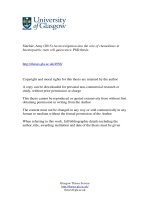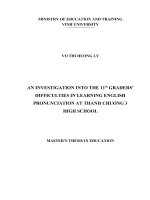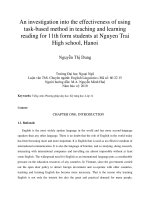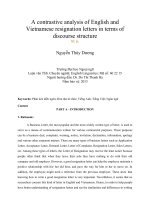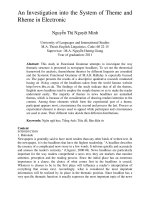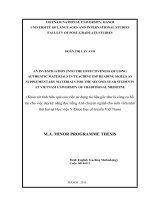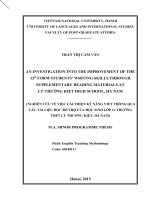An investigation into the preferred error correction techniques employed by teachers of english and suggestions for teachers in speaking lessons at green school english center, huong canh, binh xuyen, vinh phuc
Bạn đang xem bản rút gọn của tài liệu. Xem và tải ngay bản đầy đủ của tài liệu tại đây (438.08 KB, 38 trang )
HANOI PEDAGOGICAL UNIVERSITY 2
FACULTY OF FOREIGN LANGUAGES
*****
LE THI THUY TRANG
AN INVESTIGATION INTO THE PREFERRED ERROR
CORRECTION TECHNIQUES EMPLOYED BY TEACHERS OF
ENGLISH AND SUGGESTIONS FOR TEACHERS IN SPEAKING
LESSONS AT GREEN SCHOOL ENGLISH CENTER, HUONG
CANH, BINH XUYEN, VINH PHUC
(SUBMITTED IN PARTIAL FULFILLMENT OF REQUIREMENTS
OF THE DEGREE OF BARCHELOR OF PEDAGOGY IN ENGLISH)
Supervisor : TRAN THI NGAN, M.A
Ha Noi, May 2018
ACKNOWLEDGEMENTS
A completed study would not be done without any assistance. Therefore, the
author who conducted this research gratefully gives acknowledgement to their support
and motivation during the time of doing this research.
I would like to take this opportunity to express my gratitude to the people who
made it possible for me complete this thesis for graduation. First and foremost, I want
to send the deepest appreciation to my supervisor: Mrs. Tran Thi Ngan-a lecturer at
Hanoi Pedagogical University 2 for her insightful advice and suggestions and kind
encouragement. Without her help and guidance, I would not have been able to
complete my research work.
I want to express my sincere gratitude to the committee members for their
advices and invaluable feedbacks. Without their assistance, I would not be able to
complete this research.
In addition, I also wish to thank my colleagues and students in Green school
English center, Huong Canh, Binh Xuyen, Vinh Phuc who participate in the survey.
ABSTRACT
It may seem that error correction is a simple procedure which does not need to
be examined, but it is the opposite of the truth. It is necessary that teachers are wellinformed about how students perceive error correction in order to teach effectively.
Error correction is a fundamental process of language teaching. By correcting the
learners’ errors can help students to recognize where they are wrong. From that
students can enhance their use of English, especially in speaking skill. There are
different techniques which birng benefits or drawbacks to correct errors in teaching
language. In this study, the paper presents the preferred error correction techniques
which the teachers in Green School English center tend to use to correct their students’
errors.
TABLE OF CONTENT
ACKNOWLEDGEMENTS
ABSTRACT
TABLE OF CONTENT
CHAPTER 1. INTRODUCTION ....................................................................................1
1.1. Rationale ...............................................................................................................1
1.2. Research scope ......................................................................................................2
1.3. Research questions ................................................................................................ 2
1.4. Research significance ...........................................................................................2
1.5. Design of the research ...........................................................................................2
CHAPTER 2. LITERATURE REVIEW .........................................................................4
2.1. Overview of errors ................................................................................................ 4
2.1.1. Definitions of Error .................................................................................4
2.1.2. Errors versus Mistake ..............................................................................5
2.1.3. Types of Errors ........................................................................................5
2.1.3.1. Grammatical Errors ......................................................................5
2.1.3.2. Discourse errors ............................................................................6
2.1.3.3. Phonological errors ......................................................................6
2.1.3.4. Lexical errors ................................................................................7
2.2. Errors correction strategies in speaking lessons ..................................................7
2.2.1. Definitions of error correction ................................................................ 7
2.2.2. Types of error correction ........................................................................8
2.2.2.1. Teacher correction ........................................................................8
2.2.2.2. Peer correction ..............................................................................8
2.2.2.3. Self-correction ...............................................................................9
2.2.3. Common error correction techniques ......................................................9
2.2.3.1. Explicit correction .......................................................................10
2.2.3.2. Recast ..........................................................................................10
2.2.3.3. Clarification requests ..................................................................11
2.2.3.4. Metalinguistic clues .....................................................................11
2.2.3.5. Elicitation ....................................................................................11
2.2.3.6. Repetition.....................................................................................11
2.3. Timing of error correction ...................................................................................11
2.3.1. Immediate correction .............................................................................12
2.3.2. Non-Immediate Correction ....................................................................12
CHAPTER 3. METHODOLOGY .................................................................................14
3.1. An overview of the research site .........................................................................14
3.1.1. Research question ..................................................................................14
3.1.2. Participants ............................................................................................ 14
3.1.3. Research instruments .............................................................................14
3.1.4. Questionnaires .......................................................................................14
3.1.5. Classroom observation ..........................................................................14
3.2. Data analysis .......................................................................................................15
3.2.1. Data analysis from questionnaires ........................................................15
3.2.1.1. Demographic information ...........................................................15
3.2.1.2. Teachers’ error correction techniques ........................................15
3.2.2. Data analysis from Class observation form ..........................................17
CHAPTER 4. FINDINGS, DISCUSSIONS, RECOMMENDATIONS AND
APPLICATIONS ...........................................................................................................19
4.1. Findings and discussions .....................................................................................19
4.1.1. Teachers’ awareness of error correction: .............................................19
4.1.2. Teachers’ preferred error-correction strategy: ...................................19
4.1.3. Problems for Error correction............................................................... 19
4.1.4. Suggestions to improve effectiveness of using explicit correction in
speaking lessons .......................................................................................20
4.2. Recommendations ............................................................................................... 21
4.2.1. Reducing error correction frequency ....................................................21
4.2.2. Creating some activities for students to practice ..................................21
4.2.3. Correcting Errors strategically ............................................................. 22
4.2.4. Deciding Time to correct errors ............................................................ 22
4.2.5. Applying different error - correction strategies ....................................22
4.3. Applications ........................................................................................................23
4.4. Pedagogical Implication ......................................................................................23
4.5. Suggestions for further studies ............................................................................24
CHAPTER 5. CONCLUSION ......................................................................................25
5.1. Summary .............................................................................................................25
5.2. Limitation of the study ........................................................................................25
REFERENCES ..............................................................................................................26
APPENDIX 1 ................................................................................................................29
APPENDIX 2 ................................................................................................................32
CHAPTER 1
INTRODUCTION
1.1. Rationale
Due to its special importance in nowadays’ social-economic life, learning
English is necessary for a lot of people. The center of English teaching and learning is
to master four skills including speaking, listening, reading and writing. Of which,
speaking is regarded as the most difficult for learners to develop because it requires
them to produce the language most of the time spontaneously of without enough time
to construct appropriate and correct utterances. Over a long period, considerable
attention has been paid to errors and error correction in speaking classes (Ellis, 1994).
There is nobody who is able to learn a foreign language without making errors during
the phases of language acquisition. That is why this field of study deserves a great deal
of linguists’ attention.
Proving feedback and correcting errors to learners on their performance is a
fundamental aspect of teaching because making errors is a part of learning, and error
correction should be done selectively in order to have better results in the classroom.
Teachers are an essential part of this learning process, as they are usually those who
help students to correct their errors and to avoid them in the future. If error correction
is done correctly, it can make students be able to use language fluently and accurately
in the right contexts. However, if it is done incorrectly, it might bring harms to
students. For example, it can hinder the learners’ confidence of using language,
especially when they speak.
To most language teachers, correcting learners’ oral errors is one of the most
frustrating tasks because it has more potential for subjectivity due to individual
variables (Cohen, 1998). Generally, different teachers have different techniques to
correct errors. Some teachers often like showing explicitly that the learners were
wrong and giving directly correction, some others prefer to attract students’ attention
on their errors by raising teacher’s voice.
Because of that, this study is conducted with the aim to find out the preferred
error correction techniques in speaking lessons. The results contribute to enhance the
quality of teaching English in Green School English center.
1
1.2. Research scope
Due to the limits of time, ability and availability of the data, the researcher
intends to investigate the current situation of correcting errors in speaking lessons at
Green school English center and find out appropriate error-correction strategies for
application in real context. The respondents of this study are limited to the teachers at
Green school English center, therefore, their opinions of appropriate error-correction
strategies in speaking lessons might not be representative of all teachers of English
nationwide.
1.3. Research questions
The research is carried out to answer the following question:
1. What are teachers’ preferred error correction techniques in speaking lesons?
1.4. Research significance
Learners’ errors are significant to both teaching and learning, for errors are
evidence of their learning development. This study, therefore, will contribute a new
implication to second language acquisition, particularly, to the area of error correction
in speaking class. Pedagogically, information obtained from this study might help
teachers of English get insights into oral errors and oral error correction. From this
they adjust their teaching and apply appropriate error-correction strategies to make
error-correction more effective. These will help to enhance the quality of English
teaching efficiency and learning English.
1.5. Design of the research
The study consists of five main parts:
Chapter 1: Introduction: it consists of the rationales, scope, significance,
research question and design of the research.
Chapter 2: Literature Review: this chapter presents various concepts relevant
to the research topic such as the overview of errors which reviews the definitions of
errors as well as types of errors. This chapter also includes the views of appropriate
error-correction techniques in which, when, what, who and how to correct errors
effectively are mentioned in detail.
Chapter 3: Methodology: this part presents the research question, participant. It
also focuses on the data collection instruments, presentation and analysis of the data,
2
gives a detailed presentation and analysis of the data from the questionnaires and
classroom observation.
Chapter 4: Findings, Discussions, Recommendations and Applications: it
consists of some discussions and interpretations of the findings of the study. This
chapter also provides some recommendations for effective error correction in speaking
lessons. Applications, engages the practice of error correction in speaking lessons by
following the three-stage model.
Chapter 5: Conclusion: this chapter includes the summary of the study and
some pedagogical implications for correcting errors appropriately in speaking lessons.
This part also points out some limitations of the study and provides some suggestions
for further studies.
3
CHAPTER 2
LITERATURE REVIEW
Following the introduction, the theoretical assumptions as well as the findings
about error correction and error correction techniques from previous empirical
research will be reviewed to discuss the approaches to teaching and learning speaking.
This chapter will also discuss the overall views of errors. Finally, timing of error
correction will conclude the literature review.
2.1. Overview of errors
2.1.1. Definitions of Error
It is essential to understand what the term error stands for. Different teachers
have different opinions about error. These are based on their own perspectives and
aspects of study. According to Lennon (1991) an error is “a linguistic form or
combination of forms which in the same context and under similar conditions of
production would, in all likelihood, not be produced by the speakers’ native speaker’s
counterparts”. Besides that, Hendrickson (1980) defines “error” as “an utterance, form,
or structure that a particular language teacher deems unacceptable because of its
inappropriate use or its absence in real-life discourse”. Even though there are so many
definitions based on the native speaker language norms, it is apparent that the
definitions created in such way are problematic. Nowadays, the most of the language
teachers are not native speakers of the language they teach. In practice, this means that
students are permanently exposed to the nonnative language model, so the language
used in the classrooms might be different from the native speaker norm. Moreover,
teachers are more focused on students’ abilities to communicate the message, rather
than a grammatical level of the language (Allwright and Bailey, 1991). In the light of
this, an error could be a deviation from a phonological or grammatical rule, an
incorrect form or expression in a particular situation. Considering that the purpose of
the current research focuses on the correction of oral errors, it is not of primary
importance to understand all the actual reasons behind errors. Consequently, the
definition employed for the purpose of this research considers the term “error” to refer
to the language deviated from the Standard English, and/or that are deemed to be
inaccurate.
4
2.1.2. Errors versus Mistake
Errors and mistakes are a natural part of the learning process. Normally, these
two terms seem interchangeable, but in fact they are quite different from each other.
James (1998, p. 78) suggests that the difference between mistake and error can be
found in relation to the correction ability. According to him, a mistake is a fault in
learner’s statement that he is able and willing to correct. On the contrary, an error is
something that a learner is neither able nor inclined to correct. According to Corder
(1967), “errors occur due to the lack of knowledge of the proper rule”. An example for
this may be; “Although I like cities, but I prefer the countryside”. This sentence shows
that the speaker did not know the correct usage of concessive clauses or he/she might
transfer an acceptable rule of grammar from his/her mother tongue. Hence, errors
show the present level of a learner’s language development of a particular language.
And Tanner and Green (1998) define a mistake as “a slip of the tongue; the learner
knows the correct form but has temporarily forgotten it”. As a consequence, the
speaker fails to perform his/her linguistic competence. An example of a mistake is “He
goes to scool “. This occurred because the speaker has forgot the way to spell the
world “school”. Actually mistakes are non-systematic and can be self-corrected while
errors tend to be systematic and not self-corrected. In this study, there is no distinction
made between errors and mistakes as it is often intricate to determine whether it is an
error or a mistake.
2.1.3. Types of Errors
Language scientists have divided errors in many different ways throughout the
history. First of them, Burt (1975) divided errors into global errors and local errors.
The former refers to errors that have a signigicant impact on the clarity of
commnication and are “those” that affect overall sentence organization, such as wrong
word orders, missing, wrong, or misplaced sentence connectors” (p.56). On the other
side, the latter influences a single element in the sentence, but most often is not a
signigicant barrier to communication. There are, for example, errors connect to nouns,
verb imflections, articles and auxiliaries. On the basis of the linguistic levels, errors
can be dinided into four major categories as follows:
2.1.3.1. Grammatical Errors
Grammatical errors, which stress the need for Grammatical accuracy in both
speech and writing may hinder communication. Actually, the biggest distraction for
5
any language teacher with regard to error correction has been traditionally focus on in
Engish language teaching on the correction of error at a grammatical level.
Grammatical errors have two subcategories. One subcategory consists of
morphological errors and the other of errors in syntax. A morphological error involues
a failure to comply with the norm in supplying any part of any instance of the
following word classes: nouns, verbs, adjectives or difinition, as thay do not possess
any morphotogy. Into morphological errors category belong, for example, leaving out
the third person - s (she know Paul) or using the past tense - ed too often (she camed
here). These types of errors are deemed as quite basic, but persistent among the
students even on the upper levels. On the other side, syntax errors have an influence on
phrases, clauses, sentences and paragraphs with regard to, for instance, phrase
structures or inter-sentence cohesion.
2.1.3.2. Discourse errors
Discourse errors are dependable upon the observance of the rules of speaking and
reflect learners’ cultural and pragmatic knowledge of language use. An example for this
kind is “Now I ‘m learning English news. I like them”. As can be seen, this is an error of
cohesive device misuse because the speaker considered “news” a plural noun.
Hendrickson (1981) points out that pedagogy needs to be related to modes of linguistic
presentation. The approach to correcting errors in the written mode should be quite
different from the approach to correcting spoken errors. Each discourse mode demands
different correction at different acceptable periods. With spoken discourse, the question
of when to correct becomes vital to the learner's confidence and to the train of
conversation. Besides, methods for correcting oral errors are also paid much attention to.
It is extremely difficult for a spontaneous conversation or interaction to take place in
oral communicative discourse if the exchange is interrupted with corrections. As a result,
immediate correction of oral errors should not be encouraged for fear of damaging
learners’ confidence. A more suitable approach would be to encourage learners to be
conscious of the ability to monitor themselves and correct their own errors.
2.1.3.3. Phonological errors
Phonological errors are manifested in wrong pronunciation and/or intonation. For
example, the speaker mispronounced the word from [waste] to [water] in the following
sentence: “Some threw water in the forest they got a fine”. This caused difficulty for
the listener to understand. In the process of second language acquisition, such errors
6
necessitate timely correction because they may have a meaning differentiating function.
As teachers, few would expect students to be able to achieve a native sound system in
their target language. This is an area where fossilization does tend to take place.
However, a communication breakdown can occur if a phonologically-induced error is
serious enough to affect intelligibility. This is when appropriate correction is crucial in
indicating the speaker's error, as by implicit suggestions from the listener.
2.1.3.4. Lexical errors
Lexical errors may also hinder communication and intelligibility. This type of
errors can easily arise in combination with other categories. An example is a speaker's
error in the sentence: “I read a lot of books interesting”. It is a common type of lexical
errors, namely wrong word order. A more serious lexical error can be found in the
following utterance: “The man raised from the ground”. That is the misuse of the verb
“raise”. In this case, “rose” would be accurate. Like morph-syntactic errors, lexical
errors are errors which are habitually corrected by teachers. On the whole, it is easy for
teachers to correct lexical errors as one only needs to pinpoint the change in meaning
and provide the correct word.
2.2. Errors correction strategies in speaking lessons
2.2.1. Definitions of error correction
There are a lot of studies have dealt with the matter of error correction. “Error
correction” is described as “a reactive second move of an adjacency pair to a first
speaker’s or writer’s utterance by someone who has made the judgement that all or
part of that utterance is linguistically or factually wrong” (James, 1998, p. 235).
Similarly, Richards and Lockharts (1996) defines error correction as “a response either
to the content of what a student has produced or to the form of the utterance”. In a
more practical view, Edge (1989) clearly states that correction does not always mean
making everything absolutely correct but helps learners learn to express themselves
more accurately.
In language teaching and learning, the term “correction” is used to indicate that
the teacher supplies an appropriate item to response to what is perceived to be an error
(Chun et al,. 1982). In their opinion, in supplying an appropriate correction, the teacher
has to do more than just give modelling. Clearly, it is advisable to make it explicit to
the student on how the right form of language should be produced.
7
Allwright and Bailey (1991) state that the word “correction” implies a permanent
“cure”, which is different from impermanent “treatment”. They argue that even if a
teacher corrects an error and manages to get a right answer, it does not mean that the
error has permanently been cured. Since the focus of their research is to investigate the
permanent effects of teachers’ responses on learner errors, the use of the term
“correction” is considered to be appropriate.
To sum up, error correction refers to the assistance provided by either teacher,
peer, or self, with reference to any shortcomings on the part of a language learner in
the target language.
2.2.2. Types of error correction
In error correction, the use of various types of correction methods has been
recommended as it is considered to be more effective than relying upon a single one
(Lynch, 1996). The basic difference between 'error' and 'mistake' indicates a clear-cut
correction policy in terms of classroom practice: that 'errors' should normally be
corrected by teachers, by peers and by self.
2.2.2.1. Teacher correction
As the overwhelming majority of the respondents would confirm that the teacher
is certainly the one capable and authorized to correct the errors. Hendrickson (1978) is
in favor of providing the learners with teacher correction which concentrates on
correcting communicative errors rather than linguistic errors. As far as teacher
correction is concerned, teachers should correct the error in an interactive way as it is
beyond student’ language proficiency. This correction is necessary and may become
an effective learning means because the learning is based on the communicative need.
However, Maicusi et al. (1999) claim that teacher’ frequent correction of errors
actually makes the learner dependent on correction by others, especially by their
teachers. It is better for learners to be motivated to do so themselves and teachers
should help them become conscious of their error and give them incentive as well as
hints to correct the error in order to avoid repeating it in the next time.
2.2.2.2. Peer correction
Peer correction is a classroom technique where learners correct each other
instead of teacher doing this. In the classroom, peer correction is a kind of useful
method because that can make students feel more confident and less intimidated being
help by others in the class. However, some learners are highly resistant to being
8
corrected by someone other than the teacher. Cohen (1975) suggests that peer
correction may improve the learners’ ability to recognize errors. In this respect, Bruton
and Samuda (1980) claimed that peer correction is beneficial in the language
classroom. The advantage of peer correction is to help learners cooperate and involve
in the process of learning. Besides, it also makes them less dependent on the teacher.
According to Bailey (2005), peer correction can be very effective if it is done in a
positive and supportive way. Teachers might as well leave the correction for their
learners in the hope that errors can be corrected through peer work since the language
proficiency of the learners in a group varies. That is what one student cannot correct
may be corrected by other students. Besides that, if the language is out of students’
understanding, it needs the correction giving by the teacher.
2.2.2.3. Self-correction
Self-correction if when learners correct themselves instead of a teacher doing it.
Teachers can involve learners in self-correction to different degrees, by giving learners
more or less guidance as to the location and nature of their errors, and examples of good
use of language to compare their own to. For example, the learner says ‘I feel relax' and
then immediately changes this to ‘I feel relaxed'. Bailey (2005) stresses that learners may
learn more if they themselves correct their errors. In this way, they may be memorable
and could promote actual learning. According to Carroll (1955), self-correction not only
gives learners more opportunities to improve their speaking ability but activates their
linguistic competence as well (cited in Corder, 1967). However, learners have much
difficulty in self-correcting. Thus, self-correction should be done with the help of other
students or teachers. When a learner has made an error, the teachers or other students are
advisable not to provide him or her the correct form immediately but give him or her a
chance to correct it by supplying some necessary hints.
In short, each type of error correction has its own advantages and disadvantages.
It is suggested utilizing the types that are most appropriate in certain situations. Also a
combination of error correction types will make the correction more effectively.
2.2.3. Common error correction techniques
In the past decades, this has been a worthy debated issue of the appropriate
correction of learners’ errors. As a language teacher and as a language learner, it is
important to know how to correct errors in general and in speaking class in particular.
9
However, the issue of dealing with oral errors in second language learning is complex.
Once we have decided that correction is necessary, we must focus on how to correct in
a way that is both appropriate and effective. Allwright and Bailey (1991) claim that
error correction should be varied. The most comprehensible and frequently used CF
classification was made by Lyster & Ranta (1997). They divided corrective feedback
into six types which teachers use to respond to learner errors:
2.2.3.1. Explicit correction
Explicit correction refers to the explicit provision of the correct form. As the
teacher corrects the errors, he or she directly fingers out what the student is false.
Hendrickson (1980) sees that “Explicit correction is detailed direct correction
indicating that teachers provide learners with exact forms or structures of their
erroneous utterances”. According to Fanselow (1977), the most popular correction of
errors carried out by the teachers is giving the right answer. That is explicit correction.
The benefit is that when the teachers give the right answers to the learners who make
errors, the learners might not be confused. They directly recognize that their answers
were wrong. However, Norrish (1983) asserts that explicit correction of errors not only
hinders the improvement of the communicative competence but also produces negative
consequences in learners.
2.2.3.2. Recast
Recasts happen when the teacher reformulates the statement of the student,
however he does not explicitly say where did the error occur. Without directly
indicating that the student's utterance was incorrect, the teacher implicitly reformulates
the student's error, or provides the correction. Chaudron (1977) described recasts
(termed in his study as Repetition with Change) as further divisible into subtypes by
the following variant features:
• Emphasis: intonation, without which he considered this technique weak
• Reduction: modeling the correct form only of the portion that the student said
incorrectly
• Expansion: modeling the correct form with added information: liable to
confuse the student by drawing away from the correction. it is unclear from
Chaudron’s description whether this variant would further come to be considered a
combined technique involving metalinguistic feedback by Lyster and Ranta’s
definitions (1997).
10
2.2.3.3. Clarification requests
Clarification requests indicate to learners that either their statement has not been
understood by the teacher or it is somehow ill-formed. Therefore, the learner has to
repeat or reformulate their statement. Such request includes expressions like “Excuse
me?”, “I don’t understand” or similar.
2.2.3.4. Metalinguistic clues
Metalinguistic feedback is focused on providing the learner with comments,
information, or questions related to the errors in the learner’s statement. However, the
teacher does not overtly correct the error, but instead provides the learner with
metalinguistic information about the nature of the error, which should help the learner
to correct it.
For example, "Do we say it like that?", "That's not how you say it in English", or
“Is it an animal?”.
2.2.3.5. Elicitation
Elicitation is a technique that teachers use to obtain the correction of the error
directly from learners. Teachers might either on purpose pause their own statement in
order to encourage learners to fill in the rest (e.g., It is a…….) or ask them to
reformulate the statement (e.g., Say that again). Alternatively, teachers might ask
questions (e.g., how do we say it in English?) to students which should help them find
the correct answer. Elicitation questions differ from questions that are defined as
metalinguistic clues in that they require more than a yes/no response.
2.2.3.6. Repetition
As the title suggests, it is related to the repetition performed by the teacher. The
teacher repeats the student's error and adjusts intonation to draw student's attention to it.
To sum up, there is no single correction method that works effectively for all
types of errors. Each has its own advantages and disadvantages. According to Vigil
and Oller (1976, cited in Brown, 1994) error correction must be optimal in order to be
effective. Thus, language teachers have to use several different types of error
corrections depending on the types of errors, individual learners and the context of
language teaching and learning.
2.3. Timing of error correction
Correction can enable students to recognize their errors and acquire the correct
form of their target language. However, it is also tricky to decide when to correct so
11
that it will not affect the communication process. Allan (1991) states that the teachers‟
failure to correct oral errors at the appropriate time might lead to a negative reaction to
language learning in general and to error correction in particular.
2.3.1. Immediate correction
Vigil & Oller (1976) see that correcting errors immediately helps the teacher
draw students’ attention to problems while they are still fresh in their minds. However,
it interrupts their flow of speech. Hendrickson (1980) shows that learners hate to be
corrected while they are talking because the correction, to some extent, makes them
feel nervous and lose confidence. With the same view, Hammerly (1991) affirms that
immediate correction interrupts learners and can lead to loss of face which may
discourage them to speak. Moreover, immediate corrections may cause sensitive
children to develop aggressive behavior towards their classmates or teacher. Thus,
correction must not be applied unless errors frustrate communication.
It is important for the teachers to understand that every error that seems serious
does not need to be corrected immediately. Actually, it is usually counterproductive to
attempt immediate correction of all errors. Realizing this, teachers should be more
tolerant of their learner’ errors as it is better to speak with some errors rather than
waiting until they can speak accurately. To be more concrete, communication is
important in speaking lessons.
2.3.2. Non-Immediate Correction
Postponing error correction to a future time will be less effective, as time elapses
between the error and correction (Chaudron, 1987). However, this may be necessary,
particularly if the error is common to the whole class (Holley & King, 1971). Teachers
may note errors and deal with them later, either at the end of the task, lesson, or in a
following lesson. This can also provide time for the teacher to design efficient and
effective practice tasks and allow the learner a greater opportunity of self-correction
and help the development of autonomous control processes.
The decision on whether to correct immediately or not may depend on many
factors including learner sensitivities, learning situation, learning purpose and activity
type. In terms of lesson focus, teachers have to decide whether the lesson focus is on
accuracy or fluency and then design activities which help students produce accurate
language or express themselves freely to develop fluency. It is advisable not to deal
with oral errors during fluency practice.
12
An understanding of when to correct is most effective. Once we have identified
an error, we need to determine the best time to correct it so that the correction will be
helpful to the learner.
13
CHAPTER 3
METHODOLOGY
In this chapter, the research methods are described. Two methods are questionnaire
and class observation were conducted. They were designed to get the prefered error
correction method employed by the teachers of English in Green School English. Based
on the results of the survey, the error correction habit of teachers in Green School
English center has been found.
3.1. An overview of the research site
3.1.1. Research question
The research question was conducted to answer the following question:
What are teachers’ preferred error-correction techniques for speaking lesson
among teachers in Green school English center?
3.1.2. Participants
The participants are the teachers in Green School English center. They are both
Vietnamese and Filipino, aged from 23 to 35. The youngest has 1 year in teaching
English and the oldest has 5 years in teaching English. All of them are female. They all
got the Bachelor’s degree in English teaching methodology.
3.1.3. Research instruments
In order to get the needed information, the two instruments are employed. They
are questionnaires and class observation.
3.1.4. Questionnaires
This tool can help to collect information from many teachers and save time.
However, this method also has some disadvantages. Respondents may not be 100
percent truthful with their answers. This can happen for a variety of reasons, including
social desirability bias and attempting to protect privacy. This part was divided into
two parts. The first part was to get some demographic information of the teachers as
their age and years of teaching. The second part consisted of six questions to point out
their judgements and opinions about error correction techniques.
3.1.5. Classroom observation
This method will be used to get some detailed expression from teachers in Green
School English center but the questionnaires cannot do because it is only the multiplechoice questions. Besides the questionnaires, classroom observation is also the
14
instrument used to collect more data about the work of error-correction use for the
study. The researcher intends to observe the five teachers, who have different abilities
and teach different classes. The data will be collected in four lessons of each class.
Each lesson lasts 35 minutes. The classes must not be prepared for being observed.
The students and teachers do as usual. Moreover, the researcher must not do anything
to interfere with the teachers, the students and activities, that is non-participating
observation. The details of error correction are observed and filled in the Classroom
Observation Forms (COFs), (see Appendix 2).
3.2. Data analysis
3.2.1. Data analysis from questionnaires
3.2.1.1. Demographic information
The first part of the questionnaires is designed to get some demographic
information from the teachers in Green School English center. From the
questionnaires, there are 2 teachers at the age from 23 to 25 and 6 teachers at the age
from 26 to 29. And only one is at the age from 30 to 35. Most of them (7 teachers) has
from 3 to 5 years of teaching while 2 teachers have from 1 to 3 years of teaching. Only
one teacher has more than 5 years with teaching experiment.
3.2.1.2. Teachers’ error correction techniques
The second part is designed to get information of teachers about the choice of
error-correction techniques which they use in their lessons. It consists of six questions
divided into two parts. Each offers the teachers to choose which are suitable for them.
a, Frequency of error correction
The first question with the purpose to get information of the teachers about the
frequency of error correction. The data are illustrated in pie chart 1 and analyzed as below:
0% 0%
10%
always
usually
50%
sometimes
seldom
40%
never
Finger 3.1 . Frequency of error correction used
15
Regarding the frequency of error correction, 50% of the teachers always and 40%
usually correct students’ errors. The numbers of the teachers sometimes corrected
errors are 10%. And the teachers see that errors need correcting every time so that they
did not choose the choices of seldom or never (0%).
b, Teachers’ perception about the suitble error correction techniques
The second question is about the perception of the best error correction
techniques used with the teachers. Information is analyzed below:
45%
40%
35%
30%
25%
20%
15%
10%
5%
0%
40%
20%
10%
20%
10%
0%
Giving some Saying directly Require the
Showing in an
Having the
commentss, that the student students to
implicit way as student fill in
information or is wrong and repeat to help repeating the the rest of their
asking yes/no
correct the
error and asking
wrong
questions
errors
some detailed statements by
associated in
questions
pausing them
the errors
when they are
fail
Attracting the
student's
attention by
repeating the
sentence and
changing tone
of voice
Finger 3.2. Teachers’ perception about the suitble error-correction techniques
Regarding the bar chart above, it can be seen that none of the teachers uses
elicitation, which is having the students fill in the rest of their wrong statements by
pausing them when they are fail. A large number of them (40%) will give direct
corrections of the error as they might think this way works well with the students.
Showing in an implicit way as repeating the error and asking some detailed questions
and Attracting the student’s attention by repeating the sentence and changing tone of
voice got the same results with 20%. And only 10% of the teachers chose to provide
the students with comments, information or questions related to the error and indicate
to students that their statement has not been understood so they have to repeat or
reformulate their statement because they may see that these two ways works less
effectively with the students.
c, Teachers’ preferred error correction techniques
The second part is to have their choice of error-correction strategies in the four
different situations. The results were illustrated in table 1 below:
16
Metalinguistic
Explicit
Clarification
clues
correction
requests
10%
55%
15%
Recast
Elicitation
Repetition
10%
0%
10%
Table 1. The choices of error-correction techniques by the teachers
Table 1 is about the choices of error-correction methods by the English teachers.
It can be seen that most of the teachers (55%) saw explicit correction which means
giving direct correction for the learners can help the students to recognize and correct
their errors. Following next is clarification requests which accounts for 15%. A little
fewer of them (10%) believed that metalinguistic clues, recast and repetition could
help the students in speaking lessons. The rest, elicitation, which is pausing the
learner’s statement in order to encourage them to fill in the rest or ask them to
reformulate their statement, with 0% belief by the teachers.
3.2.2. Data analysis from Class observation form
In this part, the details of the classroom observation of four lessons taught by the
three teachers in three classes and in four lessons, will be presented in number and
percentage:
Frequency
of using by
teachers Teacher 1 Teacher 2 Teacher 3 Total score Average score
Techniques
Metalinguistic clues
8
5
6
19
6,3
Explicit correction
15
16
12
43
14,3
Clarification requests
7
6
3
16
5,3
Recast
10
7
3
20
6,6
Elicitation
1
3
2
6
2
Repetition
7
4
3
14
4,6
Table1. The types of error-correction methods
Tables 1 is the result of observing the classroom of the three teachers in their four
speaking lessons. Regarding the average score of correction methods used by the three
teachers, the teachers mostly used explicit correction (14,3) while the average score of
the teachers chose recast as their most-use error-correction techniques is 6,6.
Metalinguistic clues and clarification requests, which are alternately provide the
17
students with comments, information or questions related to the error and indicate to
students that their statement has not been understood so they have to repeat or
reformulate their statement, accounted for 6,3 and 5,3 respectively. Besides, repetition,
which means repeating the student’s error and adjusting intonation to draw student’s
attention to it, was 4,6. And the last was repetition which rarely used by the teachers
with the average score was only 2.
Through, observing the lessons, it was found out that error correction was not
appropriate and effective. The teachers did not always correct common and persistent
errors. A lot of attention was paid to grammatical and phonological errors. Moreover,
there was always a problem. When the teachers corrected immediately and straightly,
which broke down the students’ speech, and in some cases, the learners had to restart
their conversations or statements, not to mention their discouragement to speak. By the
way, the teachers seemed to corrected errors in a negative way, especially when the
students could not correct the errors immediately.
18
CHAPTER 4
FINDINGS, DISCUSSIONS, RECOMMENDATIONS AND APPLICATIONS
4.1. Findings and discussions
4.1.1. Teachers’ awareness of error correction:
The results of the study indicated that the teachers were still influenced much by
the traditional teaching methods. It means that they gave so much effort to explain and
talk, which consumed time and caused confusion to the students as well. Moreover, it
is difficult for the students to understand the words that why their error making is
obvious. By the way, it seems that there is still a big gap between theory and practice
in classroom.
The results of the study also demonstrated that the teachers used both explicit
types and implicit types of correction methods. However, explicit error correction was
used in most cases.
4.1.2. Teachers’ preferred error-correction strategy:
Regarding the results and the author’s observation, it can be seen that the
teachers in Green School English Center seem to use Explicit correction, which is
showing directly the correction of the learners’ errors, the most. This method can help
students know exactly where they are wrong and how to correct, but as mentioned
above it might disrupt students and hinder their speaking motivation.
4.1.3. Problems for Error correction
Based on the observation of the author, it can be seen that there are some
problems for error correction in teaching speaking. The first one is that too much
correction can make students hesitate at speaking especially the students in Green
School English center are almost primary students. Secondly, sometimes correction
does not work. Students show with their facial expressions or body language that they
are not open to correction because of the use of inappropriate error correction or
correction by teachers is not suitable with them. Thirdly, some of the teachers have not
been trained in term of error correction. They correct error based on their thought only.
This is also a big problem. Last but not least, the use of explicit correction still has
some drawbacks. So what can be done to limit them?
19
